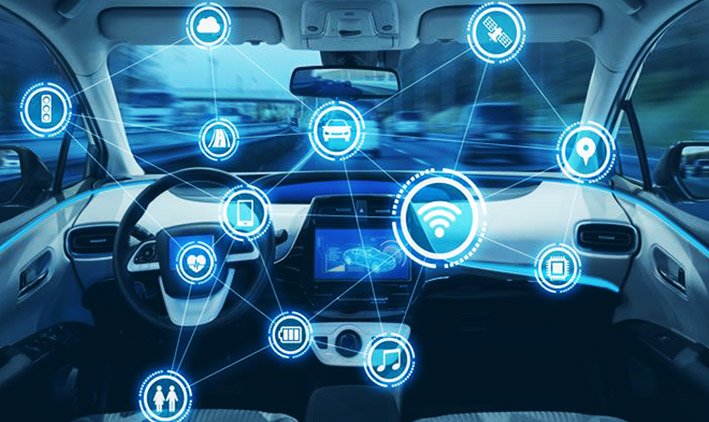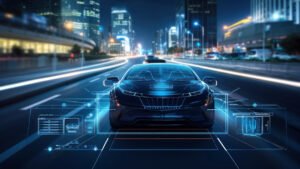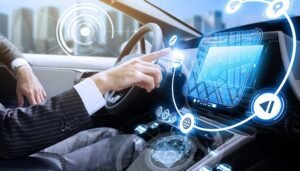Connected cars can connect to the internet and many devices, allowing them to communicate with other cars, infrastructure, and cloud services. This technology is changing the way people drive, making cars smarter, safer, and more fuel-efficient. Connected cars are changing the way people drive and communicate with their cars by sharing data, updating in real-time, and using advanced communication systems.
1. The Evolution of Connected Car Technology
The technology behind connected cars has come a long way in just a few years. It started with simple functions such as GPS navigation and Bluetooth connectivity. Since then, it has evolved into vehicle-to-vehicle (V2V) and vehicle-to-infrastructure (V2I) communication. These advancements allow cars to talk to their surroundings and provide real-time information about road conditions, traffic trends, and potential hazards. Both automakers and technology companies have invested heavily in this technology, allowing future cars to “talk” to each other and surrounding structures.
2. Why Connected Cars are Safer
One of the biggest benefits of smart car technology is that it makes driving safer. By allowing cars to talk to each other in real-time, drivers can be warned of potential hazards on the road before they are discovered. For example, if the car in front of you suddenly stops or swerves, nearby connected cars will receive the message immediately. This gives the driver more time to react. This reduces the chance of accidents and makes the roads safer overall.
Connected cars can also collect and share information about things like icy patches on the road or work zones. This data can be sent to other cars, allowing drivers to change their speed and behavior while driving, ultimately reducing the number of accidents.
3. High-tech Systems to Support Drivers
Advanced driver assistance systems (ADAS) are largely made possible by connected cars. ADAS features include lane-keeping assistance, autonomous emergency braking, adaptive cruise control, and blind spot tracking. These systems use radar, cameras, and sensors to monitor the area around the car and provide real-time assistance to the driver.
For example, automatic emergency braking can detect when a collision is imminent and apply the brakes if the driver doesn’t brake in time. Lane Keep Assist can help you avoid an accident when you leave your lane. The connectivity of modern vehicles is powering ADAS technologies that are designed to improve driving safety by reducing human error, a leading cause of accidents.
4. Vehicle-to-Vehicle Communications (V2V)
Vehicle-to-vehicle (V2V) communication allows cars to share information about where they are, how fast they’re going, and in what direction they’re going. This conversation takes place over a wireless network and can help prevent collisions by giving drivers real-time information about which other cars are driving around them.
V2V technology can let drivers know when another vehicle is following them at a blind intersection, or when it’s unsafe to change lanes. V2V technology helps drivers make better decisions by giving them an extra layer of knowledge. This reduces the risk of accidents and makes roads safer overall.
5. Vehicle-to-Infrastructure (V2I) Communication
Vehicle-to-infrastructure (V2I) communication connects cars to nearby devices such as traffic lights, road signs, and work areas. The technology helps to increase road safety, improve traffic flow, and reduce congestion.
With V2I transmission, cars can obtain information from traffic lights, allowing drivers to adjust their speed and avoid unnecessary stops at red lights. Similarly, vehicles can receive alerts when work zones or roads are about to close, allowing drivers to change routes and avoid potential hazards. V2I technology will be needed in the future to make the transportation system better and more efficient.
6. Predictive Maintenance and Vehicle Health Inspection
Connected car technology not only makes driving safer; it also makes it easier to keep your car in good condition. Many new cars have built-in predictive maintenance systems that can monitor the condition of the car at any time. These systems monitor things like battery charge, engine function, tire pressure, and other key components. If a problem is detected, the car can notify the driver or schedule a service at a nearby shop.
By fixing problems before they become worse, predictive maintenance helps prevent breakdowns and reduce repair costs. This not only keeps your car running smoothly, but it also makes your car safer overall.
7. Improve Driver Awareness
Connected car technology also makes drivers more aware of what’s happening around them and on the road. Real-time traffic information, weather updates, and hazard warnings help drivers stay alert and change the way they drive to improve safety.
For example, connected cars can let you know when there’s a sharp bend, slippery road, or heavy traffic. Being aware of these things can help drivers make more informed choices and avoid potential risks, making their journeys safer and less stressful.
8. Adding Features to Self-driving Cars
Fully autonomous vehicles are still in development, but connected cars already have some self-driving capabilities built in. Some of these include adaptive cruise control, automatic parking, and modes that allow the car to drive itself in certain situations. As connected car technology continues to evolve, it is likely to become a key component of the growth of autonomous vehicles.
By leveraging V2V and V2I communications, connected cars can better navigate through traffic, avoid obstacles, and make changes in real-time without the need for human assistance. This technology is important to making self-driving cars safe and effective in the future.
9. How to Keep Connected Cars Safe Online
As cars become more connected, they are more likely to be the subject of cyberattacks. Automakers and technology companies are increasingly concerned about hacking and data breaches in connected cars. There are vulnerabilities in car software that hackers can exploit to take over key functions such as steering and parking.
To address these issues, companies are implementing strong security measures such as firewalls, encryption, and private communication protocols. To ensure that connected cars are protected from new threats, software must be updated regularly. As connected car technology continues to evolve, cybersecurity will continue to require significant attention.
Conclusion
Connected car technology is transforming the automotive industry by making driving safer and more efficient. V2V and V2I communications, enhanced driver assistance systems, and pre-scheduled maintenance are making cars smarter and more reliable. With continued advances in 5G technology and improved security measures, the future of connected cars looks bright. In the long term, these advancements will make roads safer, drive better, and enable fully autonomous vehicles.




Comments
Good web site! I truly love how it is easy on my eyes and the data are well written. I am wondering how I could be notified whenever a new post has been made. I’ve subscribed to your RSS which must do the trick! Have a nice day!
Thank you for providing me with these article examples. May I ask you a question?
Thank you for your help and this post. It’s been great.